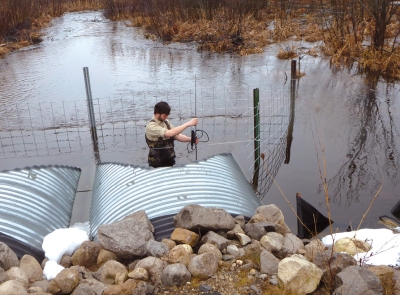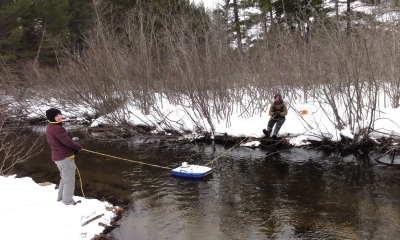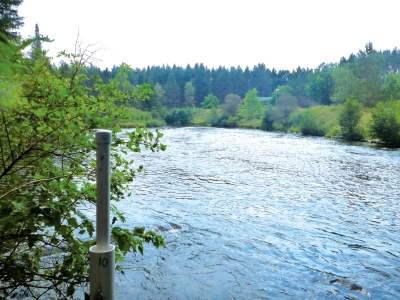Measuring Effects of Fracking in Northern Michigan Rivers
- David W. Hyndman
- Professor and Chair
- Department of Earth and Environmental Sciences
- College of Natural Science

Lab technician Blaze Budd measures discharge using an OTT acoustic digital current meter at Black Creek within the Manistee River watershed.
 The mission of the Anglers of the Au Sable is to "preserve, protect, and enhance the Au Sable River System for future generations." In 2008, the organization approached Dave Hyndman, professor and chair of MSU's Department of Geological Sciences, to find a way to measure whether fracking in northern Michigan was having an effect on the Au Sable and Manistee rivers.
The mission of the Anglers of the Au Sable is to "preserve, protect, and enhance the Au Sable River System for future generations." In 2008, the organization approached Dave Hyndman, professor and chair of MSU's Department of Geological Sciences, to find a way to measure whether fracking in northern Michigan was having an effect on the Au Sable and Manistee rivers.
One of the group's concerns was that fracking might introduce contaminants into these river systems. Michigan, however, has tougher fracking regulations than many states, and Hyndman thought fracking might be having a different kind of effect on the rivers.
"The biggest issue is likely associated with withdrawals, because fracking operations can pump over a million gallons of water for a particular frack," he said. "They are often right in the headwaters of the watershed and are pulling the water from the groundwater, but it's connected to surface water."
So the Anglers of the Au Sable and Hyndman made the decision to install stream gauges to measure stream flow and gather a longer-term data set. Thirty-nine gauges were placed in the headwaters of the Au Sable and Manistee, rather than measuring the rivers more directly downstream. "Most of the existing gauges are placed by the U.S. Geological Survey in partnership with cities or other agencies, like the Department of Transportation, who care about large flows," Hyndman said. "If you go far downstream, you're less sensitive to changes associated with human activities. There you have a lot of flow, and the change might be very small." Collecting data from areas with less flow means researchers can record subtler changes.
Gathering this data fills a more general need for information about headwaters. According to Hyndman, there are very few stream gauges in headwaters across the country. "Having gauges up in headwater areas helps us understand the effects of climate change, land use change, and human modification of systems on streamflows," he said.

Undergrad student Brianna Jansinski and lab technician Blaze Budd perform a discharge measurement using a Sontek S5 acoustic Doppler current profiler on the East Branch Ausable River.
Hyndman has been measuring stream flow since eighth grade, when a school science project had him out measuring a creek near his hometown of Missoula, Montana. "It was a good year to do it because there was a 100-year flood that year," he said. "This tiny little stream turned into something 25 feet deep, allowing me to study all kinds of issues." He continued to monitor water flow after that, and through that experience he was invited to the Intel Science Talent Search, which was an important step toward his eventual career path.
Tom Baird is president of the Anglers of the Au Sable. The group partnered with Hyndman because, in Baird's words, "We needed a 'high end' hydrogeologist with university backing for this project, who had background in this type of work and experience in northwest Michigan." When Hyndman analyzed stream gauge data from the Au Sable–Manistee headwaters, relative to when a fracking event occurred, he did find evidence that at least one particular event affected water flow. "I talked to the state about it," he said. Hyndman believed that the state planned to pursue a conversation with the people involved with the fracking project.
In addition to the water flow monitoring, Hyndman's team has also done some limited monitoring of water quality in the system, just to be sure that fracking activities in the area aren't having a significant impact. And, according to Hyndman, they've done a lot of work across Michigan's Lower Peninsula looking at water quality, trying to tie that back to human activities, including septic systems.

A sampling site on the Manistee River.
Though the initial research stage of the project has concluded, the gauges are still generating data. For the Anglers of the Au Sable, this gives the organization a tool, a way to let corporations know that someone is monitoring the rivers, that data are being recorded.
Graduate and undergraduate students help monitor the stream gauges and collect the data. They also analyze the data and write it up. "Students get an understanding of how hydrologic systems work," Hyndman said. "They get an understanding of how water flows through the system, and how humans impact those flows."
For Hyndman, the data are helping answer those larger questions about climate change and human impacts. For example, the State of Michigan has a system for monitoring large water withdrawals. A permit is required for any withdrawal over two million gallons per day. The permit is intended to "manage, protect, and conserve the waters of the state for the public trust, interest, and riparian rights."
"We're collecting the data that can feed into their system," Hyndman said. "The system that the state uses is a statistical method to estimate the impacts of pumping across the state, but it can't do very well without streamflow data from headwaters."
- Written by Matt Forster, University Outreach and Engagement
- Photos courtesy of MSU Hydrogeology Lab.